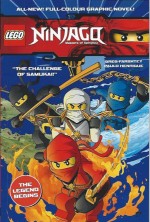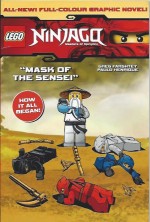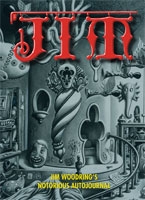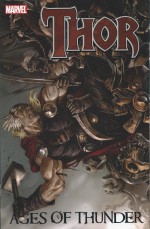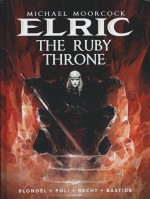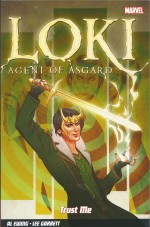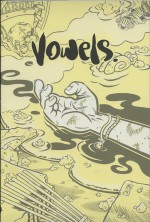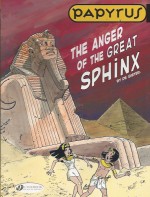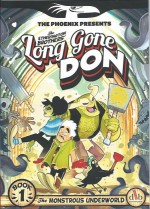
By Stan Sakai (Dark Horse Comics)
ISBN: 978-1-56971-259-7
Despite changing publishers a few times the Roaming Rabbit has been in continuous publication since 1987, with more than 30 collections and books to date. He has guest-starred in many other series (most notably Teenage Mutant Ninja Turtles and its TV incarnation) and even almost made it into his own small-screen show.
There are high-end collectibles, art prints, computer games and RPGs, a spin-off sci-fi comics serial and lots of toys. Author Sakai and his creation have won numerous awards both within the Comics community and amongst the greater reading public.
Usagi Yojimbo (which translates as “rabbit bodyguardâ€) first appeared as an extra in anthropomorphic comedy The Adventures of Nilson Groundthumper and Hermy which premiered in 1984 amongst assorted furry ‘n’ fuzzy folk in Albedo Anthropomorphics #1.
He subsequently graduated to a solo-starring act in Critters, Amazing Heroes, Furrlough and the Munden’s Bar back-up series in Grimjack.
In 1955, when Stan Sakai was two years old, his family moved to Hawaii from Kyoto, Japan. He left the University of Hawaii with a BA in Fine Arts, and pursued further studies at Pasadena’s Art Center College of Design in California.
His early forays into comics were as a letterer – most famously for the inimitable Groo the Wanderer – before his nimble pens and brushes found a way to express his passion for Japanese history, legend and the works of Akira Kurosawa and his peers, after which Sakai transformed a work-in-progress about a human historical hero into one of the most enticing and impressive fantasy sagas of all time.
Its engaging protagonist is a Bushido bunny and it’s still more educational, informative and authentic than any dozen Samurai sagas you can name…
Although the deliriously peripatetic and expansive period epic stars sentient animals and details the life of a wandering Samurai eking out as honourable a living as possible by selling his sword as a Yojimbo (bodyguard-for-hire), the milieu and scenarios all scrupulously mirror the Feudal Edo Period of Japan (roughly the 17th century AD by our Christian reckoning) whilst simultaneously referencing other cultural icons from sources from Zatoichi to Godzilla.
Miyamoto Usagi is brave, noble, industrious, honest, sentimental, gentle, artistic, empathetic, long-suffering and conscientious: a born soldier whose master has been murdered, now devoted to the spiritual tenets of Bushido. He simply cannot turn down any request for help or ignore the slightest evidence of injustice. As such, his destiny is to be perpetually drawn into an unending panorama of incredible situations.
The title was as much a nomad as its star. This guest-star-stuffed eighth monochrome masterpiece marshals yarns released by Mirage Publishing as Usagi Yojimbo volume 2, #7-14, and comes with an Introduction from writer James Robinson, after which the medieval mystery play resumes with ‘The Music of Heaven’ wherein Miyamoto and a wandering flock of tokagé lizards (ubiquitous, omnivorous reptiles that populate the anthropomorphic world, replacing scavenger species like rats, cats and dogs in the fictitious ecosystem) encounter a gentle, pious priest whose life is dedicated to peace, music and enlightenment…
When their paths cross again later, the ronin is almost murdered by a ruthless assassin who has killed and impersonated the holy man Komuso in an attempt to catch Usagi off guard…
Evocative and movingly spiritual, this classic of casual tragedy perfectly displays the vast range of storytelling Sakai can pack into the most innocuous of tales.
More menaces from the wanderer’s past reconnect in ‘The Gambler, The Widow and the Ronin’ as a professional gambler who fleeces villagers with rigged samurai duels plies his shabby trade in just another little hamlet.
Unfortunately this one is home to his last stooge’s wife, and whilst his latest hired killer Kedamono is attempting to take over the business, to make matters worse the long-eared nomad who so deftly dispatched his predecessor Shubo has just strolled into town looking for refreshments…
Again forced into a fight he doesn’t want, Miyamoto makes short work of blustering Kedamono, leaving the smug gambler to safely flee with the entire take. Slurping back celebratory servings of Saké, the villain has no idea that the inn where he relaxes employs a vengeful widow and mother who knows just who really caused her man’s death…
‘Slavers’ then begins a particularly dark journey for the ronin as Usagi stumbles across a boy in chains escaping from a bandit horde. Little Hiro explains how the ragtag rogues of wily “General†Fujii have captured an entire town and are making the inhabitants harvest all their crops for the scum to steal…
Resolved to save them the rabbit infiltrates the captive town as a mercenary seeking work, but is soon exposed and taken prisoner.
‘Slavers Part 2’ finds Miyamoto stoically enduring the General’s tortures until the boy he saved bravely returns the favour, after which the Yojimbo’s vengeance is awesome and terrible.
However even as the villagers rebel and take back their homes and property, chief bandit Fujii escapes, taking Usagi’s daishÅ (matched long and short swords) with him.
As previously seen, to take a samurai’s swords is to steal his soul, and the monster not only has them but continually dishonours them by slaughtering innocents as he flees the ronin’s relentless pursuit.
‘Daisho – Part One’ opens with a hallowed sword-maker undertaking the holy methodical process of crafting blades and the harder task of selecting the right person to buy them. Three hundred years later, Usagi is on the brink of madness as he follows the bloody trail of Fujii, remorselessly picking off the General’s remaining killers whilst attempting to redeem those sacred dispensers of death…
The chase leads him to another town pillaged by Fujii where he almost refuses to aid a wounded man until one of the women accuses him of being no better than the beast he hunts…
Shocked back to his senses Miyamoto saves the elder’s life and in gratitude the girl Hanako offers to lead him to where Fuji was heading…
‘Mongrels’ then changes tack as erstwhile ally and hard-to-love friend Gennosuké enters the picture. The irascibly bombastic, money-mad bounty-hunter and conniving thief-taker is on the prowl for suitably profitable prospects when he meets the Stray Dog: his greatest rival in the unpopular profession of cop-for-hire.
After some posturing and double-dealing wherein each tries to edge out the other in the hunt for Fujii they inevitably come to blows and are only stopped by the fortuitous intervention of the rabbit ronin…
‘Daisho – Part Two’ sees the rugged individualists come to a shaky truce in their overweening hunger to tackle the General. Mistrustful of each other they nevertheless cut a swathe of destruction through Fujii’s regrouped band, but even after the furious ronin regains his honour swords there is one last betrayal in store…
Older, wiser and generally unharmed, Gen and Usagi then part company again as ‘Runaways’ once more takes a peek into Usagi’s past. Stopping in a town he hasn’t visited in years, the rabbit hears a name called out and his mind goes back to a time when he was a fresh young warrior in the service of Great Lord MifunÄ—.
Young princess Takani Kinuko had been promised as bride to trustworthy ally Lord Hirano and the rabbit had been a last-minute replacement as leader of the “babysitting†escort column to her impending nuptials.
When an overwhelming ambush destroyed the party, Usagi was forced to flee with the stuck-up brat, both masquerading as carefree, unencumbered peasants as he strove to bring her safely to her husband-to-be through a seeming army of ninjas killers.
The poignant reverie concludes in ‘Runaways – Part 2’ as valiant hero and spotless maid fell in love whilst fleeing from the pitiless, unrelenting marauders on their heels. Successful at last, their positions naturally forced them apart once she was safely delivered.
Shaken from his memories the ronin moves on, tragically unaware that he was not the only one recalling those moments and pondering what might have been…
This emotional rollercoaster ends on a note of portentous foreboding with ‘The Nature of the Viper’, opening a year previously when a boisterous, good-hearted fisherman pulled a body out of the river and nursed his amazingly not dead catch slowly back to health. If he expected gratitude or mercy the peasant was sadly mistaken, as the victim explained whilst killing as soon as he was able.
Jei is a veritable devil in mortal form, believing himself a “Blade of the Godsâ€; singled out by the Lords of Heaven to kill the wicked. The maniac makes a convincing case: when he stalked Usagi the monster was struck by a fortuitous – or possibly divinely sent – lightning bolt and is still keen to continue his quest…
This medieval monochrome masterwork also includes a gallery of covers to charm and delight one and all.
Fast-paced yet lyrical, informative and funny, and always astoundingly action-packed, Usagi Yojimbo alternately bristles with tension and thrills and frequently breaks your heart with irresistible tales of pride, triumph and tragedy.
Simply bursting with veracity and verve, this is a perfect comics experience: monolithic, magical tales of irresistible appeal that will delight devotees and make converts of the most hardened hater of “funny animal†stories.
Text and illustrations © 1994, 1995, 1998 Stan Sakai. All other material and registered characters are © and™ their respective owners. Usagi Yojimbo and all other prominently featured characters are registered trademarks of Stan Sakai. All rights reserved.



